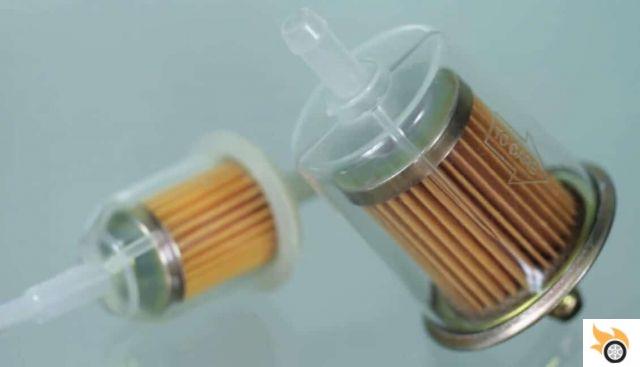
Fuel filter article
Introduction
Welcome to our article on the fuel filter. In this comprehensive guide, we'll provide you with all the information you need to know about this essential component of your vehicle's fuel system. From its definition and location to its importance and how to maintain it, we will explain everything step by step. Also, we will talk about the symptoms of a dirty fuel filter and how to change it properly.
What is the fuel filter?
The fuel filter is a key component in your car's fuel system. Its main function is to filter the impurities present in the fuel before they reach the engine. These impurities can include dirt particles, rust, sludge, and other contaminants that can clog fuel injectors and cause long-term engine damage.
fuel filter location
The location of the fuel filter may vary depending on the model and year of your vehicle. In most cases, it is located near the fuel tank or in the fuel line, between the tank and the engine. It can be mounted on the chassis of the car, in the engine compartment, or even inside the fuel tank.
Fuel filter functions
The fuel filter has several important functions:
- Filter impurities: As we mentioned before, its main function is to filter the impurities present in the fuel before they reach the engine.
- Protect Fuel Injectors: Fuel injectors are responsible for spraying fuel into the combustion chamber. A clean fuel filter prevents impurities from clogging the injectors and affecting their performance.
- Prevent engine damage: Impurities in the fuel can damage internal engine components, such as valves and cylinders. A fuel filter in good condition helps prevent this damage and prolongs the life of the engine.
Importance of fuel filter maintenance
Proper maintenance of the gasoline filter is crucial for the proper functioning of your vehicle. A dirty or clogged fuel filter can cause various problems, such as decreased engine performance, difficulty starting the car, jerks during acceleration, and increased fuel consumption.
It is recommended to follow the manufacturer's maintenance guidelines for replacing the fuel filter. In general, it is recommended to change it every 20,000 to 30,000 kilometers or according to the instructions in the owner's manual. However, if you drive in extreme conditions, such as in very dusty areas or with poor quality fuel, you may need to change it more frequently.
How to change the gasoline filter step by step
Here is a step-by-step guide to changing the fuel filter:
Step 1: Gather the necessary tools
Before you start, make sure you have the right tools on hand. This may include a wrench, pliers, protective gloves, and a container to catch spilled fuel.
Step 2: Locate the fuel filter
Check your owner's manual or research online to find the exact location of the fuel filter on your model vehicle. Once you've located it, make sure the engine is cool before proceeding.
Step 3: Disconnect the fuel system
Before removing the fuel filter, you must disconnect the fuel system to prevent leaks. This can be done by depressurizing the system or disconnecting the fuel pump fuse. Consult your owner's manual for specific instructions.
Step 4: Remove the old fuel filter
Using the appropriate tools, loosen the clamps holding the fuel filter in place. Then, remove the fuel lines connected to the filter. Be careful not to spill fuel, and be sure to place a container under it to catch any spillage.
Step 5: Install the new fuel filter
Put the new fuel filter in place and reconnect the fuel lines. Be sure to tighten the clamps properly to prevent leaks. Then, reconnect the fuel system following the manufacturer's instructions.
Step 6: Check and test
Once you've installed the new fuel filter, check to make sure everything is properly connected and secured. Then start the engine and check for leaks. If everything seems to be in order, take a test drive to make sure the vehicle is working properly.
Symptoms of a dirty fuel filter
A dirty fuel filter can cause various symptoms in your vehicle. Some of the more common symptoms include:
- Hard to start: If the fuel filter is clogged, it can make it difficult to start the engine.
- Loss of power: A dirty fuel filter can affect engine performance, causing a loss of power during acceleration.
- Pulling or vibrations: If the fuel filter is not filtering properly, it can cause pulling or vibrations in the vehicle.
- Increased fuel consumption: A clogged fuel filter can make the engine work harder, resulting in increased fuel consumption.
Frequently Asked Questions (FAQs)
1. How often should I change the fuel filter?
In general, it is recommended to change the fuel filter every 20,000 to 30,000 kilometers or according to the instructions in the owner's manual. However, this can vary depending on driving conditions and the type of fuel used. It's always best to consult your owner's manual or speak with a trusted mechanic for specific recommendations for your vehicle.
2. Can I change the fuel filter myself?
Yes, changing the fuel filter is a relatively simple task that you can do yourself if you have the right tools and follow the correct instructions. However, if you are not comfortable performing this task or do not have a background in auto mechanics, it is always best to seek the help of a professional.
3. What happens if I don't change the fuel filter?
If you don't change the fuel filter on a regular basis, it can cause various problems in your vehicle. A dirty fuel filter can clog fuel injectors, affect engine performance, cause decreased fuel efficiency and, in the long run, damage internal engine components. Therefore, it is important to perform proper maintenance and change the fuel filter according to the manufacturer's recommendations.
Conclusion
In short, the fuel filter is an essential component of your vehicle's fuel system. Its main function


























